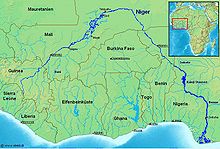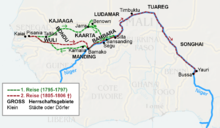Niger (river)
The Niger is after the Nile and the Congo with 4184 kilometers, the third-longest stream of Africa . It flows in a semicircle with a diameter of almost 2000 km through five states: from its source in the mountains of Guinea , it flows through Mali , southern Niger , along the border of Benin and finally through populous Nigeria , where it flows into the more than 200 km wide Niger Delta flows into the Gulf of Guinea .
The river supplies almost all of the 110 million people who live on its banks with water. Its catchment area covers 2.261 million square kilometers, including areas in another four to five states. The allocation of the desert areas is uncertain, however.
course
The Niger rises in the mountains of the Faranah region , in the state of Guinea, not far from the border with Sierra Leone. He unites with the Mafou , Niandan , Milo and reaches the city of Siguiri before leaving Guinea. The river flows in an arc to the northeast, crosses Bamako and forms the great Niger inland delta, the Massina , in Mali , the main port of which is Mopti . It then turns to Timbuktu , where it crosses the southern Sahara and changes its direction of flow towards the southeast. At Gao it flows past the red dune of Koyma and reaches the Sahel region again . He then crosses the state of Niger, whose capital Niamey is built on its banks. In the further course it partially forms the border with Benin , where the W National Park is located on a W-shaped bend of the river in the triangle of the states Niger, Burkina Faso and Benin . From there it flows on to Nigeria . After leaving the Kainji reservoir, it flows through the Lower Kaduna-Middle Niger Floodplains , a protected area of the Ramsar Convention, in the western part of Nigeria . At the height of Lokoja it takes up the left tributary Benue , leaves the large Sudan landscape and reaches the rainforest areas of Nigeria. At the level of the city of Onitsha , the Niger begins to fan out and form the Niger Delta. The river water reaches the Gulf of Guinea , which is part of the South Atlantic , in several river arms, of which the Forcados , Nun and Escravos form the three great estuary. Thus it crosses mountains, rainforest, steppe, savannah and desert.
Water data
Catchment area
The Niger catchment area extends over 10 states. It is divided as follows (based on 2.274 million km²):
| Country | Catchment area of the state in [km²] | Percent of the area of the catchment area | Percent of the country's area |
|---|---|---|---|
| Guinea | 97.780 | 4.3 | 39.4 |
| Ivory Coast | 22,739 | 1.0 | 7.4 |
| Mali | 579.856 | 25.5 | 46.7 |
| Burkina Faso | 77,314 | 3.4 | 28.0 |
| Algeria | 193.285 | 8.5 | 8.1 |
| Benin | 45,479 | 2.0 | 41.2 |
| Niger | 563,939 | 24.8 | 44.5 |
| Chad | 20,466 | 0.9 | 1.6 |
| Cameroon | 88,684 | 3.9 | 18.8 |
| Nigeria | 584,404 | 25.7 | 63.2 |
| total | 2,273,946 | 100.0 |
Hydrometry
Like most rivers in the region, the runoff of the Niger is dependent on the rainy season. It is under the influence of the precipitation regime of the West African monsoon system . The flow rate of the river was measured for over 40 years (1952 to 1992) in Malanville , a city in Benin, about 1100 km upstream from the mouth of the Niger.

The mean annual flow rate observed in Malanville was 1053 m³ / s during this period; a minimum flow of 18 m³ / s (almost completely dry) and a maximum flow of 2726 m³ / s were observed. Currently about 6000 m³ / s of water flow into the Atlantic Ocean at the river mouth.
The flow rates of the Niger vary greatly over the course of the river, due to the geography and the climatic zones it flows through. In the Sahel and the Massina, for example, it loses large amounts of water through evaporation and irrigation. Even if its catchment area extends through the Azawagh basin far north to Algeria, it receives almost no runoff from the arid area. Only with the Sirba from Burkina Faso and from the Mékrou from Benin does it have more water-rich tributaries again.
Tributaries
The main, but also the last, major tributary of the Niger is the Benue , which only flows into central Nigeria. This and other tributaries are in the confluence order (selection):
| Guinea | Mali | Niger (from Burkina Faso) |
Benin | Nigeria |
|---|---|---|---|---|
Localities

Localities on Niger are:
history
The atypical course of the Niger has puzzled European researchers for two millennia. In ancient times, Roman geographers assumed that the river near Timbuktu was part of the Nile, whereas in the 17th century European explorers were convinced that the river flowed west and flows into Senegal .
discovery
In 1796 the British African explorer Mungo Park was one of the first Europeans to reach the Niger River. His travelogue Travels in the Interior of Africa is still considered a classic today. In 1805 he went on a second expedition along the Niger between Bamako and Bussa in northwest Nigeria, where he died in 1806. It was not until 1830 that an expedition by the English brothers Richard and John Lander discovered the course of the Niger up to the mouth. The source of the Niger was discovered by European researchers (the French Marius Moustier and the Swiss Josua Zweifel ) only in 1879.
course
Today's geographers usually explain the boomerang shape of the river with a theory that the Niger consists of two ancient, interconnected rivers. The upper Niger from the source in the Loma Mountains to the Niger knee originally flowed into a now dry lake, whereas the lower Niger originated in hills near the lake and flowed south to the Gulf of Guinea. When the Sahara dried up between 4000 and 1000 BC, the two rivers changed their course and met. This theory is generally prevalent today, but has encountered isolated contradictions.
Catchment area
During the so-called Green Sahara Period (10,000 to 2000 BC), today's endorheic Lake Chad ( Mega Chad ) had a significantly larger area and its drainage over the Mayo Kébbi . Thus, the catchment area of the Niger increased to include the entire Chad basin with a size of 2.434 million km².
etymology
The name of the river probably comes from the Latin or Portuguese word for 'black' ( niger ) as a misinterpretation of the name for the river in the Tuareg language : ghir n-igheren 'river of the rivers' . The name was already used in a map by Claudius Ptolemy for a river south of the Atlas Mountains. The West African states Niger and Nigeria are named after the river. Its residents have a large number of different names for the river, including Joliba in the Manding languages and Isa Ber in Songhai . Both words mean 'great river'. Near the mouth, the Niger was also known as Kworra or Quorra , before it was recognized by Europeans in the 19th century that the upper section flowing inland does not flow into Lake Chad or the Nile, but turns south to the already known Quorra.
navigability

In the upper part, the Niger is navigable with smaller boats, but hippos, among other things, pose a certain danger. From Koulikoro , about 60 km downstream from Bamako, the river can be navigated with larger boats and ships as far as Lokoja , near the mouth of the Benue tributary into the Niger, and only during the flood period between October and January. The navigability of the Niger at the Niger knee has deteriorated in recent years due to silting up as a result of advancing dune formation.
Niger Basin Authority
The Niger Basin Authority ( French Autorité du Bassin du Niger ; NBA or ABN) is an intergovernmental organization to jointly use and promote the resources of the Niger Basin.
See also
literature
- Michael Obert: Magic rain. On the Niger into the interior of Africa. 5th edition. National Geographic Paperback, 2010, ISBN 3-89405-249-X .
Individual evidence
- ↑ a b GRDC - The Niger in Malanville
- ^ FAO - The Niger River basin
- ↑ Frédéric Bouchette, Mathieu Schuster, Jean-François Ghienne, Cléa Denamiel, Claude Roquin, Abderamane Moussa, Patrick Marsaleix, Philippe Duringer: Hydrodynamics in Holocene Lake Mega-Chad. (PDF) (English)
- ^ Molefi Kete Asante: The History of Africa. The Quest for Eternal Harmony , 2nd ed., Routledge, 2015, p. 76.
Web links
- Official website of the NBA, ABN
- World Bank Sending $ 500 Million Funding for Niger Basin Development . In: Voice of America online July 4, 2007. Archived from the original on July 11, 2007. Retrieved July 17, 2007.
- Niger Basin Initiative . World Wildlife Fund - WARPO / Freshwater Program for Western Africa Coordination Office.
- Memorandum of Cooperation between Ramsar and the Niger Basin Authority ( Memento of June 28, 2008 in the Internet Archive ), The Bureau of the Convention on Wetlands, 2002.
- Phase of decision-making of the Niger Basin Authority (August 2006) ( Memento of March 2, 2007 in the Internet Archive ), Label France N ° 61- Africa on the move , French Ministry of Foreign and European Affairs.





